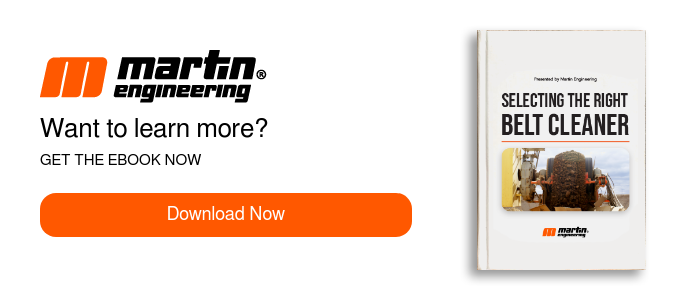How To Correctly Install, Tension, & Maintain Conveyor Belt Cleaners
Optimizing Belt Cleaner Performance: Installation, Tensioning, and Maintenance Best Practices
Blade-to-belt cleaning pressure is maintained by a tensioning device. These tensioners range in sophistication from concrete block counterweights and locking collars to torque storage couplings and engineered air-spring systems customized to the plant’s preferences.
Tensioning Systems
All tensioning systems should be designed to allow the passage of mechanical splices and other obstructions. Tensioners should be self-relieving to minimize the risk of injury to personnel or damage to equipment if the blades are "pulled through" by obstructions or holes in the belt. A tensioning device should be compatible with the cleaner to provide consistent blade-to-belt pressure throughout the blade’s life. When cleaner adjustment and re-tensioning are required, the tensioner should allow for this maintenance to be performed without requiring tools or more than one service worker.
Urethane Blade Cleaners
Some cleaners use the resilience of a urethane blade, which, when compressed and locked into position, supplies the cleaning pressure. When installed, these blades are deflected by being forced against the belt. As the blade wears, it “stands taller” to maintain cleaning pressure. Because the blade supplies both cleaning pressure and shock-absorbing capacity, the cleaner does not require a conventional tensioner. Instead, the blade assembly is forced against the belt, and the mainframe is locked into position, slightly compressing the blades to set the initial blade-to-belt pressure.

Belt Cleaner Adjustment Methods
There are two methods for belt cleaner adjustment:
- Linearly adjusted cleaners are pushed up (in a line) against the belt.
- Radially adjusted cleaners are installed with the mainframe as an axis and rotated into position.

Radially adjusted cleaners have several practical advantages over linear design. They are easier to install, can be adjusted from one side of the belt, and can more readily rotate away from the belt to absorb the shock inherent in belt motion and splice passage.
Linearly adjusted cleaners generally require access to both sides to provide even adjustment. Because of this, the tensioners for these cleaners often have some form of powered adjustment, such as an air bag, that can be remotely controlled. Linear tensioners maintain a constant cleaning angle as the blade wears and can be designed to allow for easy withdrawal of the cleaner for maintenance without removing the tensioner. In addition, some hybrid systems incorporate vertical tensioning with a radial relief mechanism. Maintaining the angle of the blades against the belt is important for ensuring effective cleaning. If the angle of contact is altered by blade wear, cleaner performance will similarly “decay.” A well-designed belt cleaner must control the cleaning angle across its wear life.
Importance of Proper Installation
A critical factor in the performance of any belt-cleaning system is its installation. Improper installation will adversely affect cleaner performance, reducing blade life and cleaning efficiency. The installation instructions from the manufacturer should be closely followed.
Installation Considerations
Considerations affecting the installation position of a belt cleaner include:
- Cleaner design
- Tensioner and mounting requirements
- Bolting or welding the cleaner in place
- Installation on chutewall or hung from stringer
- Position of conveyor structural beams, bearings, and drives
Ensuring Proper Distance
Regardless of the brand of belt cleaner, the critical factor in cleaner installation is that the cleaner support frame be installed at the correct distance from the surface of the belt. Placing the cleaner at the proper distance from the belt helps avoid “pull-through” problems, in which the belt pulls the cleaner into the belt and all the way around into an inverted position, usually resulting in a bent mainframe. Maintaining the proper dimension places the blades at the correct angle of attack against the belt for the best cleaning, proper blade wear, and longest life. The correct distance will vary from cleaner to cleaner.

Manufacturer Installation and Maintenance
It is strongly recommended that the manufacturer install and maintain the belt cleaners on both new and retrofit applications, as most performance problems with new belt cleaner systems are due first to improper installation and second to a lack of maintenance. Using the manufacturer (or manufacturer-approved contractors) for installation ensures proper installation and continued performance.
